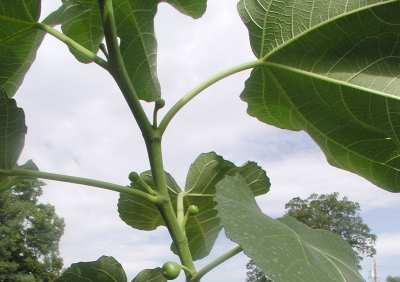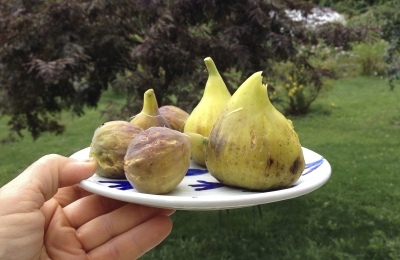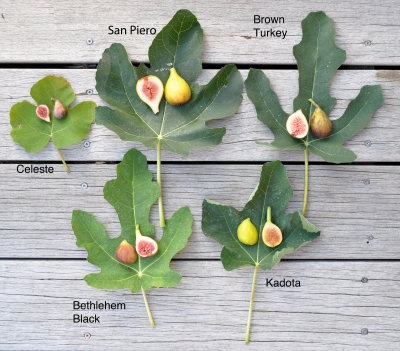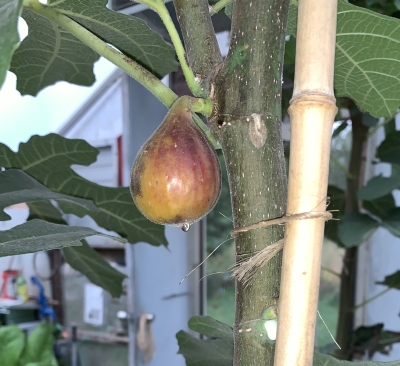WAITING FOR FIGS
(Much of the below information is gleaned from my book Growing Figs in Cold Climates and a video I presented, now available online.)
Affliction
If you’re not growing figs because you think your cold winter climate is wrong for them, you’re wrong and you’re missing out on an exotic treat. Figs can be grown just about everywhere. If you are growing figs and you’re in a cold winter climate, the fruits should be nearly or already ripening.
Impatience is the affliction of the cold climate fig grower. I’m feeling it right now, as I write. That impatience comes from watching little figlets forming and expanding early in the season and then just sitting on the branches, doing nothing, seemingly forever. Knowing something of how fig fruits develop and grow, and ways that ripening can be hastened along helps soothe my affliction.
of how fig fruits develop and grow, and ways that ripening can be hastened along helps soothe my affliction.
Let Me Know Thy Ways (of Fruiting)
Most varieties of figs bear fruit on new, growing shoots. This bearing habit is very different from that of most common fruits, such as apples, peaches, and blueberries, which bear fruit on stems that are one-year-old or older. (Some fig varieties do bear on one-year-old stems, and some bear on both one-year-old and new, growing shoots.) Figs’ bearing habit is a boon to cold climate fig growers because that means that a fig tree can still bear fruit even if its stems freeze back or are pruned back rather severely.

Figs forming on new shoot
But it takes time for fruits on young fig stems to develop and ripen, which they do sequentially from the bottom (the oldest) part of the growing stem to the top. The closer a stem originates to the roots, the longer it takes for fruit on that stem to develop and ripen. That time could be too long, depending on how severely the plant was pruned or froze back and the length of the growing season. I like to develop and leave one or more permanent trunks at least two feet long, letting sprouts grow from or at their tops.
Some so-called “hardy” figs sprout new shoots from ground level after dying back from winter cold. Actually, since ground temperatures in winter are milder than air temperatures, many figs will do this. Problem is that figs will form on those sprouts from ground level but may not have time to ripen.
Quicken the Pace
Assuming a portion of trunk or trunks have survived winter, perhaps because the plant was potted and moved to shelter, the trunk was insulated, or the trunk was buried, etc., impatience still lurks. (I detail a number of ways to get figs through winter in my book Growing Figs in Cold Climates.) The problem — for us, not the figs — is that fruit growth follows a sigmoidal (S-shaped) curve over time. That is, the fruits swell up rapidly early in the season, then just sit for a long time.
But hang tight. If all else is in order, fruit growth leaves the flat part of the curve, and figs start to rapidly swell, at the same time softening and developing a rich, sweet flavor. How long before ripening begins depends on the where the fruiting shoot originated, the variety, and the growing season.
Fortunately, you can hasten along ripening to some degree. The first way is earlier in the season, when a shoot has just a few leaves, say about five. If you pinch out the growing tip, that could stimulate figs down along the stem to start developing sooner than if the stem was left alone. However, doing so also might reduce total yield because shoot growth is at least temporarily stalled.
As fruits near ripening, they can be hurried along by “oiling.” Do this by putting a drop of olive oil in the eye of a fruit; I just dip a chopstick in the oil and then let the oil drip off onto the eye.  Very important: Don’t try this on a fruit very far from ripening, which is, of course, hard to tell until the fruit starts ripening. But if you really love your fig tree, you’ve been staring at it a lot. As you do so you’ll begin to notice subtle changes. I’ve typically used this method towards the end of the growing season when fig ripening slows with waning sunlight and cooling temperatures.
Very important: Don’t try this on a fruit very far from ripening, which is, of course, hard to tell until the fruit starts ripening. But if you really love your fig tree, you’ve been staring at it a lot. As you do so you’ll begin to notice subtle changes. I’ve typically used this method towards the end of the growing season when fig ripening slows with waning sunlight and cooling temperatures.
Wait!
Whatever you do, don’t harvest any figs before they are fully ripe. Figs, like many other fruits do not ripen at all once they have been harvested. Incipient rot might make harvested, underripe fruits a bit sweeter, but that’s different from ripe. Commercial figs are harvested just short of full ripeness because then they can be shipped without damage.

When your fig is fully ripe, the fruit is soft and perhaps has a “tear” in its eye. The flavor will be sweet and rich.

